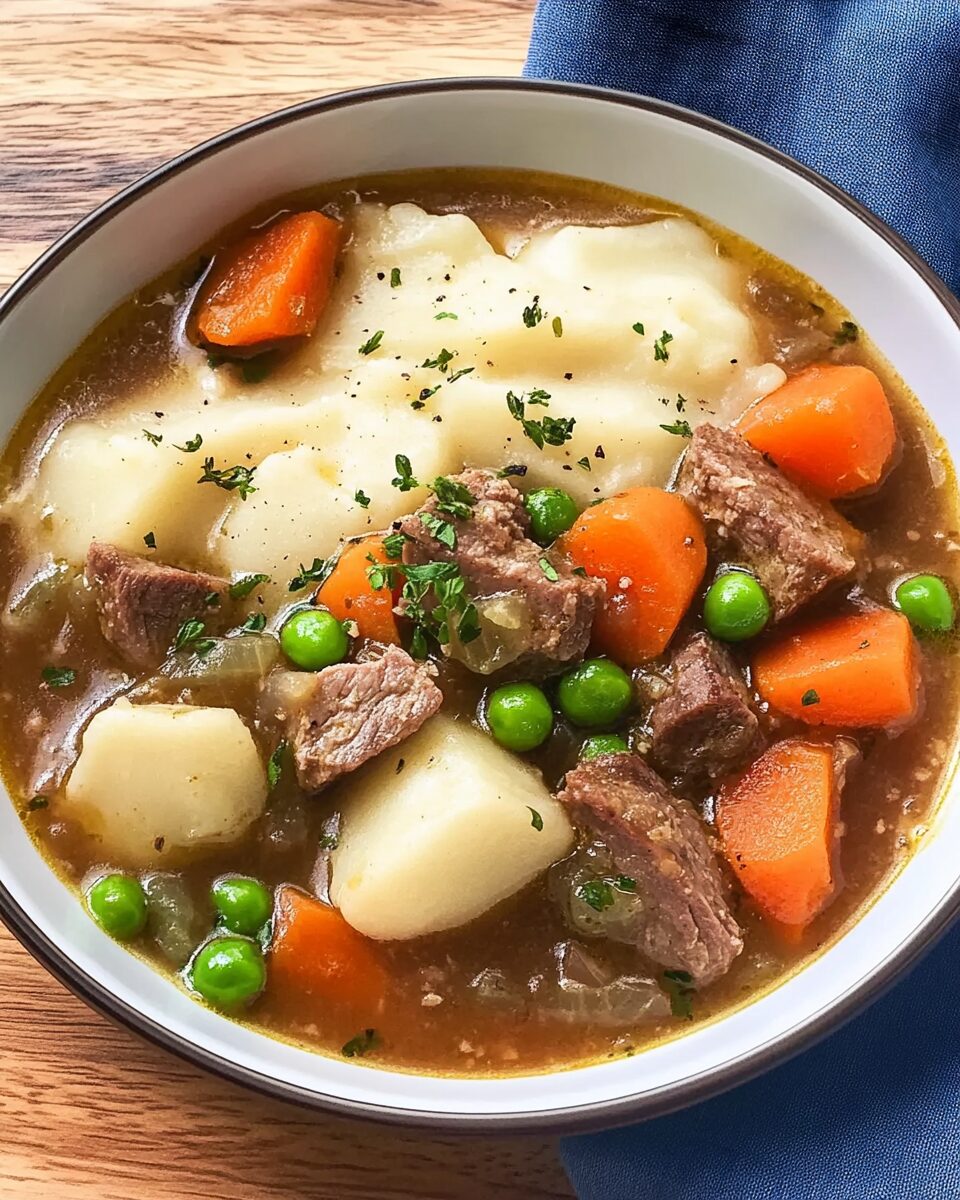Irish Stew is a classic, hearty dish that brings the rustic flavors of Ireland to your table, perfect for a comforting dinner during chilly evenings. This time-honored recipe features tender lamb, robust vegetables, and a savory broth, all simmered together to create a rich, satisfying meal steeped in tradition. Ideal for family gatherings or a casual dinner, Irish Stew embodies the spirit of slow-cooked home comfort.
Full Recipe:
Ingredients
- 2 lbs lamb stew meat, trimmed and cut into 1-inch cubes
- 2 tablespoons all-purpose flour
- 4 cups water (or lamb broth for extra flavor)
- 1 large onion, coarsely chopped
- 4 cloves garlic, minced
- 4 medium potatoes, peeled and cubed
- 4 carrots, peeled and cut into chunks
- 1 cup turnips or parsnips, peeled and cubed (optional)
- 1 bay leaf
- ½ teaspoon dried thyme
- ½ teaspoon salt (adjust to taste)
- ½ teaspoon ground black pepper
- 2 tablespoons chopped fresh parsley (for garnish)
Directions
- Coat lamb – Lightly dust lamb cubes with flour.
- Brown lamb – Heat oil in a large pot or Dutch oven over medium-high heat. Sear lamb in batches until browned. Return all lamb to the pot with any juices.
- Sauté aromatics – Add chopped onion and minced garlic. Cook until onion softens.
- Add liquid & veggies – Pour in water or broth. Stir in potatoes, carrots, and turnips (if using).
- Season – Add thyme, bay leaf, salt, and pepper.
- Simmer – Bring to a boil, then reduce heat to low. Cover and cook for 1.5 to 2 hours until lamb is tender.
- Finish – Remove bay leaf, adjust seasoning, and stir in parsley before serving.
Nutrients
- Calories: Approximately 400 per serving (based on 6 servings)
- Total Fat: 20g (of which Saturated Fat: 8g)
- Cholesterol: 90mg
- Sodium: 300mg
- Total Carbohydrates: 35g (Dietary Fiber: 5g, Sugars: 6g)
- Protein: 30g
The History and Cultural Significance of Irish Stew
Irish Stew is one of the most iconic and beloved dishes of Ireland, with deep historical roots that date back centuries. This hearty meal was traditionally made by Irish peasants using simple, affordable ingredients that were readily available. The dish emerged as a practical and nourishing way to make use of tough cuts of meat, particularly mutton, and was slowly simmered to create a flavorful, tender stew.
As a staple of Irish cuisine, the dish evolved alongside Ireland’s agricultural practices and socio-economic landscape. During the 19th century, many rural families relied on sheep for both wool and meat, making mutton a natural choice for stews. Over time, potatoes, onions, and other root vegetables became essential additions, reflecting Ireland’s agrarian traditions.
Irish Stew also holds a special place in Irish cultural identity, often associated with gatherings, hospitality, and comfort food that brings families together. It is a dish that transcends generations, maintaining its authenticity while allowing for slight variations in preparation based on regional influences and available ingredients.
Traditional Ingredients and Variations
While the core components of Irish Stew remain consistent—meat (usually lamb or mutton), potatoes, onions, and water—many cooks have put their own spin on the dish. Traditionalists insist on using mutton for its rich, deep flavor, but modern recipes often opt for lamb due to its more tender texture and shorter cooking time.
Different regions in Ireland have their own preferred ways of preparing the stew. Some variations include carrots, parsnips, leeks, and even barley to add more depth and texture. While purists believe in keeping the stew simple with only salt and pepper for seasoning, contemporary versions sometimes incorporate herbs like thyme, parsley, or bay leaves for enhanced flavor.
Another point of debate among chefs and home cooks is whether or not to add a thickening agent. Some prefer to let the starch from the potatoes naturally thicken the broth, while others may use flour or a roux to achieve a heartier consistency.
The Cooking Method: A Slow and Steady Process
Irish Stew is meant to be cooked low and slow, allowing all the flavors to meld together over time. Traditionally, it was made in large pots over an open fire, simmering for hours until the meat became tender and the broth infused with rich, savory goodness.
Today, many people use slow cookers or stovetop methods to achieve the same effect. The key to a perfect Irish Stew lies in patience—letting the ingredients cook slowly ensures a flavorful and deeply satisfying dish. Some cooks even prepare it a day in advance, as the flavors develop further when left to rest overnight.
Pairing Irish Stew with the Right Sides and Drinks
While Irish Stew is filling on its own, it is often enjoyed with a side of crusty bread or traditional Irish soda bread to soak up the flavorful broth. Some also serve it with mashed potatoes, colcannon (a mix of potatoes and cabbage), or buttered vegetables for an even heartier meal.
As for drinks, a pint of Guinness is a classic pairing with Irish Stew, as the rich, malty flavors of the beer complement the deep, savory taste of the dish. Other popular choices include a smooth Irish whiskey, a full-bodied red wine, or even a simple cup of black tea for a non-alcoholic option.
Irish Stew in Modern Cuisine
Despite its humble origins, Irish Stew has remained a timeless dish that continues to be celebrated around the world. It is a staple at Irish pubs, family dinners, and festive occasions, especially on St. Patrick’s Day. Chefs and home cooks alike have embraced creative adaptations, incorporating new ingredients while staying true to the dish’s comforting essence.
In recent years, plant-based versions of Irish Stew have gained popularity, using mushrooms, lentils, or jackfruit as meat substitutes while still maintaining the dish’s hearty appeal. These adaptations cater to changing dietary preferences while ensuring that the soul of Irish Stew remains intact.
Conclusion
Irish Stew is more than just a meal—it is a symbol of Ireland’s rich history, resilience, and culinary heritage. Its simplicity, affordability, and deep flavors have made it a cherished dish for generations, and it continues to be enjoyed by people worldwide. Whether prepared in the most traditional manner or with modern twists, Irish Stew remains a comforting, hearty dish that embodies the warmth and hospitality of Irish culture.






